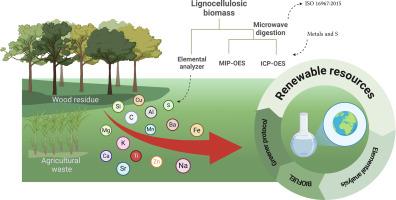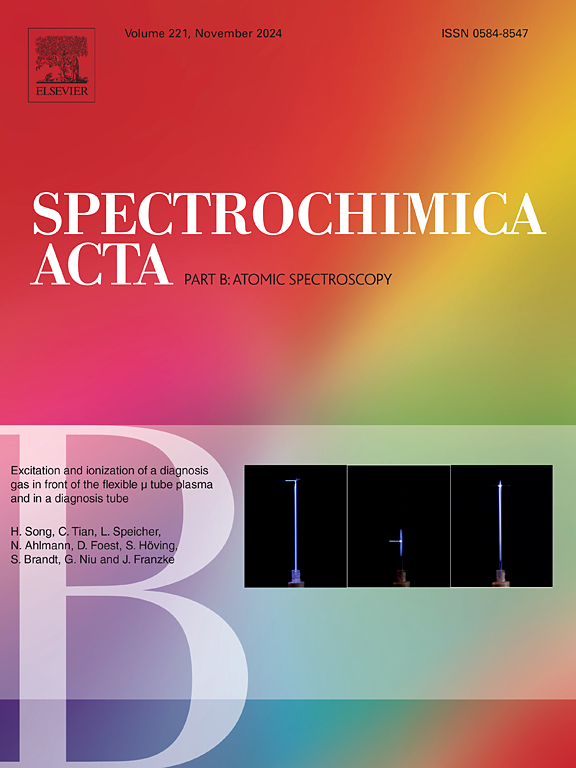木质纤维素生物质中金属和硫含量的评估:开发一种用光学发射光谱法表征灰分组成的简单方法
IF 3.8
2区 化学
Q1 SPECTROSCOPY
引用次数: 0
摘要
木质纤维素生物质在生物燃料生产方面具有很高的潜力。了解其化学成分对于了解最终产品中的污染和选择适当的转化技术至关重要。因此,本研究旨在优化甘蔗秸秆(SS)、甘蔗渣(SB)、松木渣(PWR)和桉树木渣(EWR)中元素测定的替代分析方案。采用电感耦合等离子体发射光谱法和微波诱导等离子体发射光谱法测定了样品中的金属和硫,并研究了一种高效、绿色的样品制备方案。将硝酸(0.5 mL)、过氧化氢(0.20 mL)、氢氟酸(0.06 mL)和硼酸(0.6 mL)混合用于样品消化,结果准确(79 ~ 116%)。与EN ISO 16967标准方法相比,开发的方案将试剂体积减少了16倍,同时保持了在置信限内的准确性(方差分析,p < 0.05)。以甘蔗叶片标准物质(CRM Agro C1005a)为研究对象,在优化条件下对该方法的准确性进行了分析。MIP-OES定量限为1.00 ~ 1096 μg−1 (Si)。在元素含量方面,Ba、Cu和Sr在所有样品中含量较低,为<;1 μg−1 (Cu),而Al、Ca、K和Si在SS和SB中含量为0.1 ~ 0.4%;Ca和K是压水堆和EWR的主要污染物(0.09 ~ 0.1%)。本文章由计算机程序翻译,如有差异,请以英文原文为准。

Assessment of metals and sulfur content in lignocellulosic biomass: developing a simple method for characterizing ash composition by optical emission spectrometry
Lignocellulosic biomass presents a high potential for biofuel production. Knowledge of its chemical composition is essential to understand the contamination in the final products, and to select appropriate conversion technology. Hence, this study aimed to optimize an alternative analytical protocol for elemental determination in sugarcane straw (SS), sugarcane bagasse (SB), pine wood residue (PWR) and eucalyptus wood residue (EWR). Metals and sulfur were determined by inductively coupled plasma optical emission spectrometry and microwave-induced plasma optical emission spectrometry and optimization of a powerful and greener sample preparation protocol was investigated. The combination of nitric acid (0.5 mL), hydrogen peroxide (0.20 mL), hydrofluoric acid (0.06 mL) and boric acid (0.6 mL) for sample digestion resulted in accurate results (79 to 116%). The developed protocol reduced the reagent volume by up to sixteen times compared to the EN ISO 16967 standard method while maintaining accuracy within the confidence limit (ANOVA, p < 0.05). A certified reference material of sugarcane leaves (CRM Agro C1005a) was analyzed under optimized conditions to evaluate the accuracy of the proposed method. Limits of quantification ranged from 1.00 μg g−1 (Cu) to 1096 μg g−1 (Si) by MIP-OES. Regarding the elemental content, Ba, Cu, and Sr were typically found at lower levels in all samples, at <1 μg g−1 (Cu) whereas Al, Ca, K, and Si reached 0.1 to 0.4% in SS and SB; Ca and K were the main contaminants in PWR and EWR (0.09 to 0.1%).
求助全文
通过发布文献求助,成功后即可免费获取论文全文。
去求助
来源期刊
CiteScore
6.10
自引率
12.10%
发文量
173
审稿时长
81 days
期刊介绍:
Spectrochimica Acta Part B: Atomic Spectroscopy, is intended for the rapid publication of both original work and reviews in the following fields:
Atomic Emission (AES), Atomic Absorption (AAS) and Atomic Fluorescence (AFS) spectroscopy;
Mass Spectrometry (MS) for inorganic analysis covering Spark Source (SS-MS), Inductively Coupled Plasma (ICP-MS), Glow Discharge (GD-MS), and Secondary Ion Mass Spectrometry (SIMS).
Laser induced atomic spectroscopy for inorganic analysis, including non-linear optical laser spectroscopy, covering Laser Enhanced Ionization (LEI), Laser Induced Fluorescence (LIF), Resonance Ionization Spectroscopy (RIS) and Resonance Ionization Mass Spectrometry (RIMS); Laser Induced Breakdown Spectroscopy (LIBS); Cavity Ringdown Spectroscopy (CRDS), Laser Ablation Inductively Coupled Plasma Atomic Emission Spectroscopy (LA-ICP-AES) and Laser Ablation Inductively Coupled Plasma Mass Spectrometry (LA-ICP-MS).
X-ray spectrometry, X-ray Optics and Microanalysis, including X-ray fluorescence spectrometry (XRF) and related techniques, in particular Total-reflection X-ray Fluorescence Spectrometry (TXRF), and Synchrotron Radiation-excited Total reflection XRF (SR-TXRF).
Manuscripts dealing with (i) fundamentals, (ii) methodology development, (iii)instrumentation, and (iv) applications, can be submitted for publication.

 求助内容:
求助内容: 应助结果提醒方式:
应助结果提醒方式:


